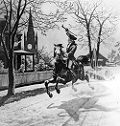10 things you didn’t know about Paul Revere
0 Comments

midnight ride
In the first of a series of articles about the history of military intelligence in the United States, the public affairs office of the Defense Intelligence Agency offered on April 16 an intriguing glimpse of the life of Paul Revere, who it calls “the most famous military intelligence agent from the American Revolution.”
“American intelligence activity began long before actual independence from the British in 1776,” explains the DIA on its Web site. “Let’s start from the beginning with the intelligence operations conducted by one of the United States’ most well-known patriots.”
Here are 10 things you didn’t know about Paul Revere:
- He is arguably the most famous military intelligence agent from the American Revolution, but most people don’t realize he was more than a guy on a horse.
- Revere was a member of the first American intelligence network on record known simply as “the mechanics” or the Liberty Boys.
- Organized out of Boston, Mass., the mechanics descended from the Sons of Liberty organization — the group that famously opposed the Stamp Act.
- The group resisted British authority and collected intelligence long before the night of Revere’s midnight ride.
- In a lesser known, but equally important, operation December 1774, Revere rode to the Oyster River, N.H., to warn that the British planned to seize Fort William and Mary. Armed with this intelligence, the 400 members of the colonial militia raided the fort and captured gunpowder that would later be used by to cover their retreat from Bunker Hill.
- Along with the mechanics, Revere would purposely sabotage or steal British military equipment around Boston.
- At the beginning of the war, Revere and his network learned that the British planned to raid the towns of Lexington and Concord to seize the weapons store there. He and others successfully warned the local militias, known as the Minutemen, who removed the weapons and resisted the raids.
- After arranging the warning lanterns to be hung in Old North Church April 18, 1775, to alert patriot forces at Charlestown, Revere completed his primary mission of notifying Samuel Adams and John Hancock.
- Revere was actually apprehended by the British en route, interrogated and released.
- Revere then completed yet another mission: retrieving from the local tavern a trunk belonging to Hancock and filled with incriminating papers.








